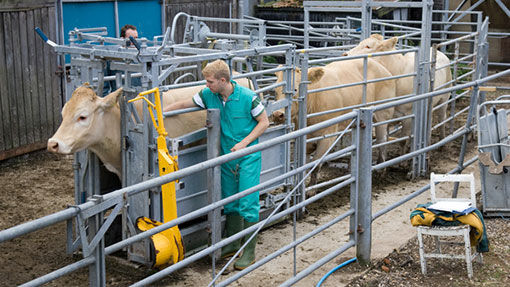Scientists back whole-herd slaughter to cut TB

All cattle on farms infected with bovine TB should be slaughtered, say researchers investigating ways of controlling the spread of the disease.
The first national model to investigate the spread of bovine TB was developed by researchers at Warwick University. Improved testing, vaccination of cattle and culling all cattle on infected farms would be the most effective strategies for controlling the disease, it suggested.
The majority of herd outbreaks are caused by multiple transmissions routes, it said. These include failed cattle infection tests, cattle movement and reinfection from environmental reservoirs, such as infected pastures and wildlife.
The model sought to ascertain how and why the epidemic has grown over the past 15 years. Using Animal Health and Veterinary Laboratories Agency and Defra data, researchers developed a mathematical model that incorporated both within-farm and between-farm TB transmission.
While badgers form part of the environmental reservoir, the study suggested, they only play a relatively minor role in the transmission of infection. Instead, it suggested measures to contain the disease should be largely cattle-based.
See also: High Court challenge to pilot badger culls
“Our model offers a dispassionate, unbiased view of the spread of TB through the cattle industry of Great Britain,” said model co-author Matthew Keeling, from Warwick’s School of Life Sciences and Department of Mathematics.
“All controls have advantages, disadvantages and would be problematic and costly to implement. However, we find only three controls have the power to reverse the current increase in cases; more frequent or more accurate testing, vaccination of cattle and culling all cattle on infected farms.”
Matthew Keeling, Warwick University
Professor Keeling said the model aimed to provide policymakers with the best evidence possible from which to make decisions relating to TB and to contribute to the ongoing discussions on what was a sensitive issue. But there was no single panacea.
“All controls have advantages, disadvantages and would be problematic and costly to implement. However, we find only three controls have the power to reverse the current increase in cases; more frequent or more accurate testing, vaccination of cattle and culling all cattle on infected farms.”
Co-author Ellen Brooks-Pollock of Cambridge University said: “By using the most recent data our model predicts that it is most likely both cattle movements and the local environment that are driving the front of the epidemic.”
The study found that the vast majority of infected farms don’t spread the infection to any other farms before they clear the infection themselves. “Only a small number of farms spread the infection and they can cause the majority of new cases,” said Dr Brooks-Pollock.
The researchers argue that the findings are essential for improving the targeting control measures. If infected farms can be identified and caught early then it might be possible to make substantial progress in tackling the epidemic.
The measures the researchers investigated were designed to be “idealised” control options. Dr Brooks-Pollock said: “We didn’t consider the practicalities or economics of implementing control measures – that needs to be the subject of further work.”
